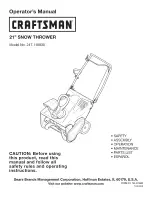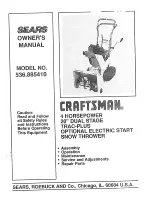
PRODUCT SPECIFICATIONS
Gutter blower
Model
R18EZBLW
Rated voltage
18 V d.c.
Air velocity
252 km/h
Air volume
132 m
3
/h (78 CFM)
Weight
(without battery)
3.2 kg
Tool length at maximum
extension
2.5 m
Vibration level (according to EN 50636-2-100 Annex BB)
Total value
0.1 m/s²
Uncertainty of measurement
1.5 m/s²
Noise emission level (according to EN 50636-2-100 Annex CC)
A-weighted sound pressure
level at operator’s position
85.3 dB(A)
Uncertainty of measurement
2.5 dB
A-weighted sound power
level (
L
WA
)
107.9 dB(A)
Uncertainty of measurement
(
K
WA
)
3.2 dB
L
WA
+
K
WA
112 dB(A)
BATTERY AND CHARGER
Model
R18EZBLW
Battery pack
-
Weight
-
Charger
-
Weight
-
Compatible
battery pack
RB1815C, RB1820C, RB1840C, RB1840X,
RB18L13, RB18L26, RB18L15, RB18L15A,
RB18L15B, RB18L20, RB18L20A, RB18L25,
RB18L25A, RB18L30, RB18L30A, RB18L40,
RB18L40A, RB18L50, RB18L50A, RB18L60,
RB18L60A, RB18L90, RB18L90A
Compatible
charger
BCL14181H, BCL14183H, BCS618, RC18627,
RC18627UV, RC18150U, RC18120, RC18115,
RC18118C, BCL14181V
REPLACEMENT PARTS
Harness
308319004
NOTE:
Visit your local special orders desk or contact RYOBI
Customer Service for replacement parts.
NOTE:
The telescopic pole from this tool is only compatible
with the models: OHT
18
, OPP
18
, OLP
18
, and the included
R
18
EZBLWA.
WARNING!
The declared vibration total values and the
declared noise emission values given in this instruction
manual have been measured in accordance with a
standardised test and may be used to compare one tool with
another. They may be used for a preliminary assessment
of exposure.
The declared vibration and noise emission values represent
the main applications of the tool. However, if the tool is used
for different applications, used with different accessories,
or poorly maintained, the vibration and noise emission
may differ. These conditions may significantly increase the
exposure levels over the total working period.
An estimation of the level of exposure to vibration and noise
should take into account the times when the tool is turned off
or when it is running idle. These conditions may significantly
reduce the exposure level over the total working period.
Identify additional safety measures to protect the operator
from the effects of vibration and noise, such as maintaining
the tool and the accessories, keeping the hands warm (in
case of vibration), and organising work patterns.


































